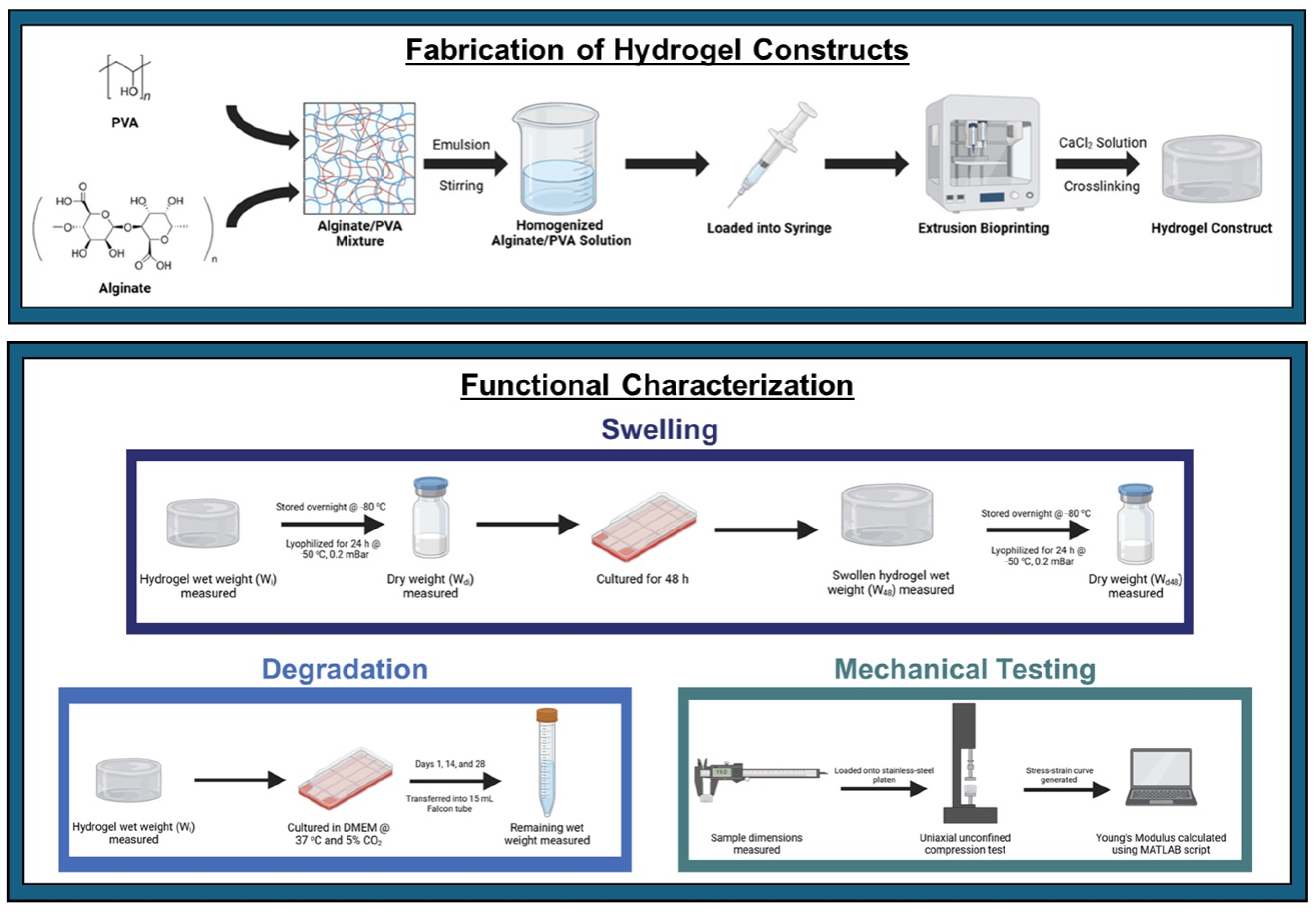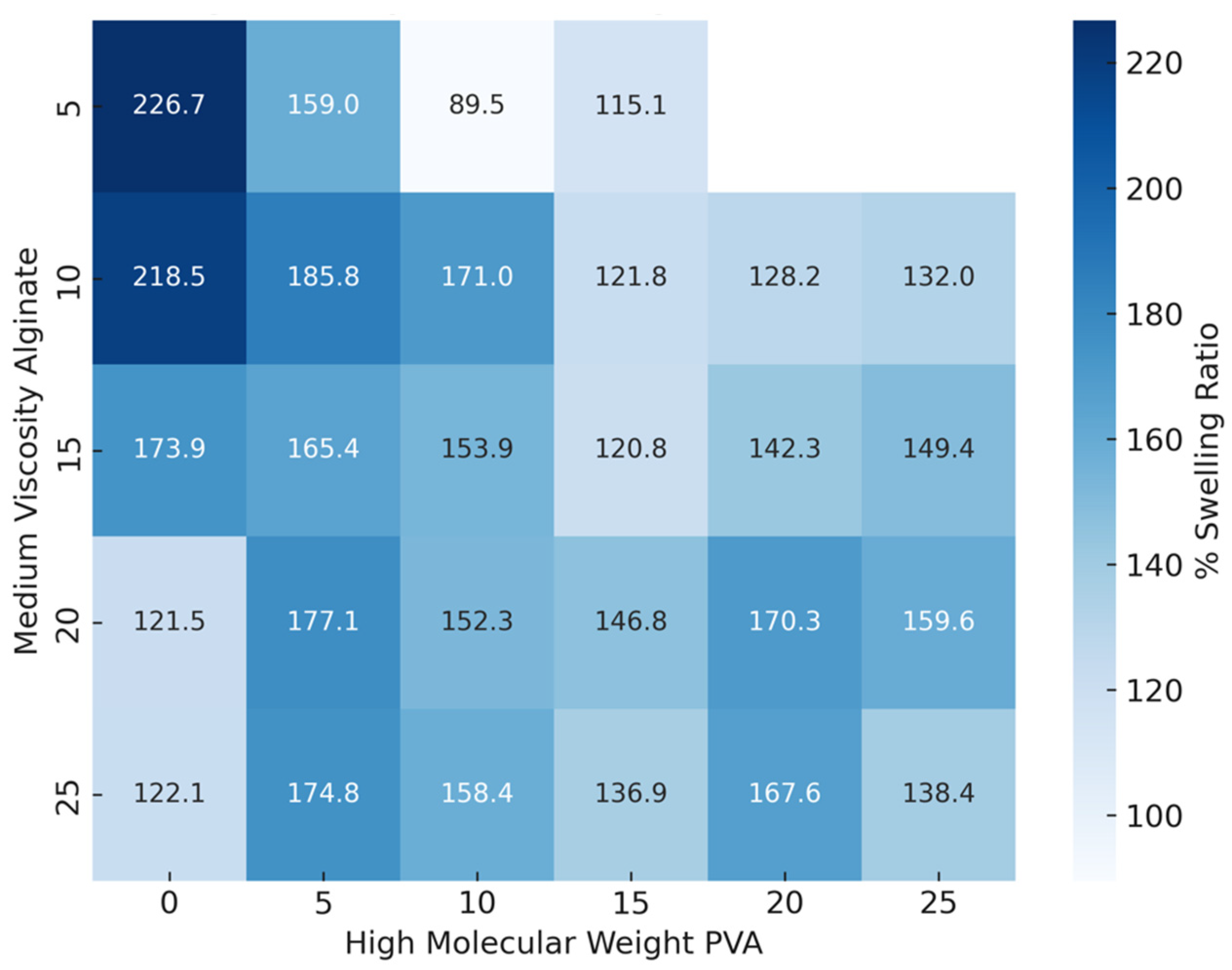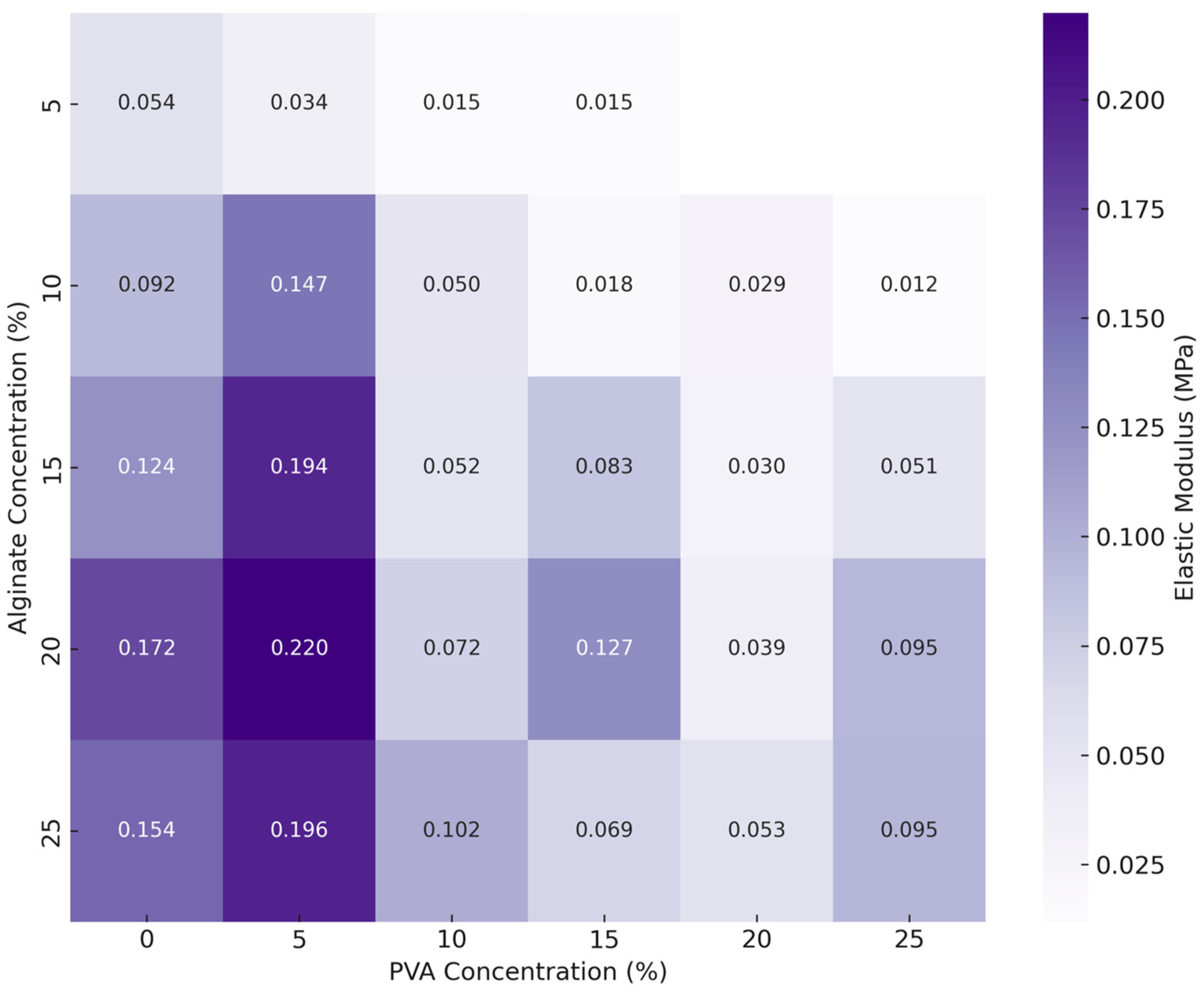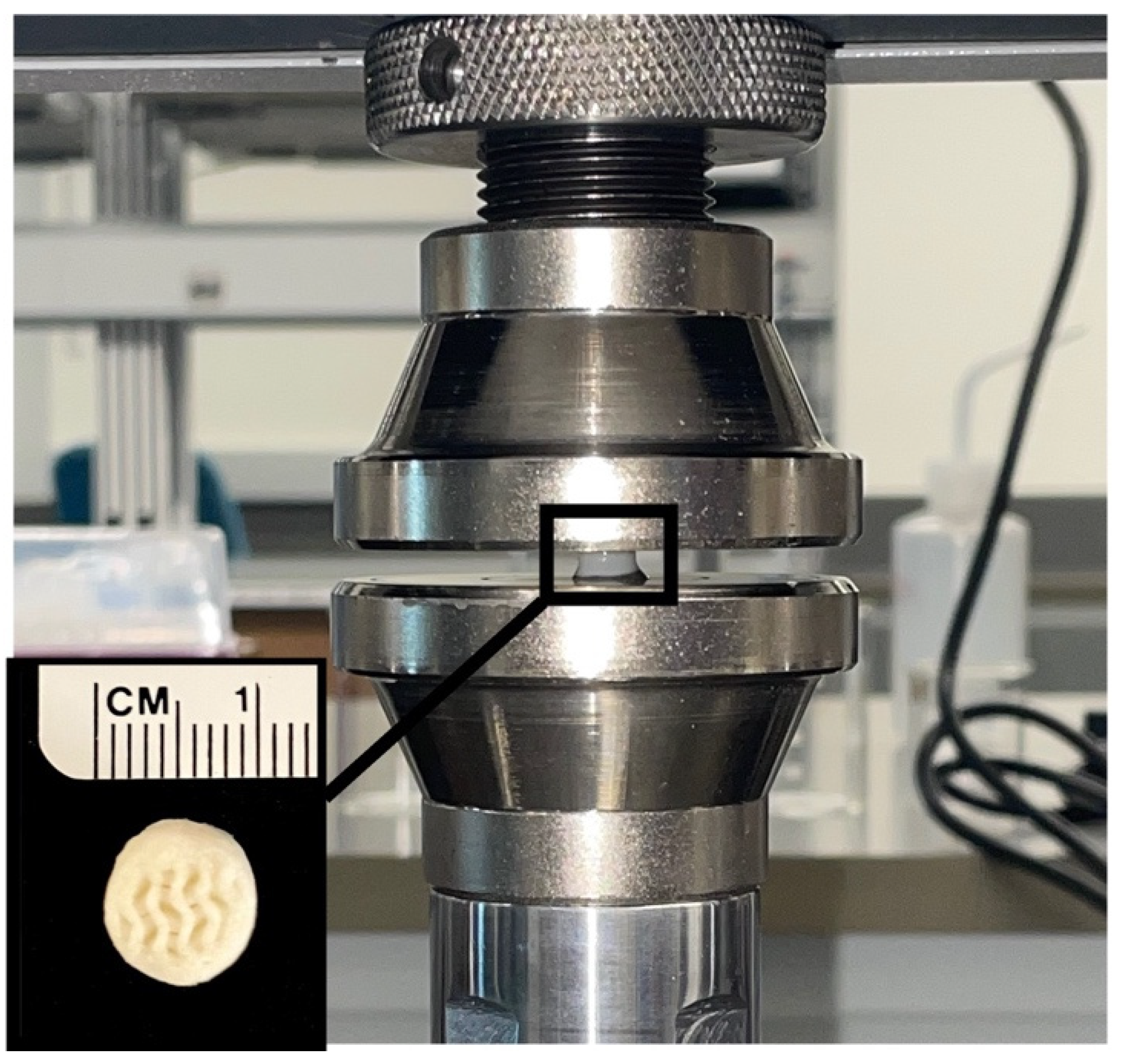2.2. Swelling
The 48-h swelling ratio of hydrogel samples was analyzed as a function of both alginate and PVA concentrations, revealing distinct trends in response to these variables (
Figure 2). For varying alginate concentrations, the mean percent swelling ratios range from 147.6% (±60.1) at 5% alginate to 159.5% (±46.9) at 10% alginate. As the alginate concentration increases, the swelling values remain fairly stable, with a mean percent swelling value of 150.9% (±20.8) at 15% alginate, 154.6% (±21.0) at 20% alginate, and 149.7% (±21.5) at 25% alginate. Despite the range in swelling percentages, alginate concentration alone did not have a statistically significant effect on the swelling ratio (F = 0.614,
p = 0.654), and pairwise comparisons confirmed the absence of significant differences between alginate concentrations. These results suggest that, within the tested range, alginate concentration has a relatively minor impact on the swelling behavior of the hydrogel matrix.
In contrast, PVA concentration showed a significant main effect on percent swelling across the different formulations independent of alginate concentration (F = 11.115,
p < 0.001), highlighting PVA’s dominant role in influencing water uptake and retention. The mean percent swelling values range from 128.3% (±15.4) at 15% PVA to 172.5% (±61.2) at 0% PVA. This reduction in swelling with increasing PVA concentration was further confirmed by post hoc comparisons, which revealed that hydrogels containing 15% PVA exhibited significantly lower swelling than those with 0% and 5% PVA (both
p < 0.001). This finding emphasizes that intermediate levels of PVA (around 15%) yield the most substantial reduction in swelling, highlighting the potential of these concentrations to modulate hydrogel hydration properties in controlled tissue-engineering applications (
Figure 2B).
A significant interaction effect between alginate and PVA concentrations was observed (F = 5.650,
p < 0.001), indicating that the influence of PVA concentration on swelling behavior is modulated by the specific level of alginate concentration present in the bioink formulation. The 3D plot in
Figure 2C visually demonstrates this interaction, suggesting that higher PVA concentrations generally lead to lower swelling, while the alginate concentration exerts a subtler, secondary impact. This combined analysis underscores that, under the tested conditions, PVA concentration exerts a more pronounced effect on swelling behavior compared to alginate concentration.
Given the overall significance of PVA concentration on the 48-h swelling of the hydrogels, we further analyzed its effect within each fixed alginate concentration (
Figure 3). When using 5% alginate, increasing the PVA concentration generally led to a reduction in swelling, with mean swelling decreasing from 226.7% at 0% PVA to 115.1% at 15% PVA, with the ANOVA results indicating a significant effect of PVA concentration on percent swelling (
p = 0.002). This trend was observed across all but 10% alginate, with significant effects of PVA concentration on swelling found at 15% alginate (
p = 0.006), 20% alginate (
p = 0.001), and 25% alginate (
p < 0.001).
At each alginate concentration, increases in PVA from 0% to 15% or to 20% typically resulted in lower swelling percentages, with the most pronounced reductions occurring between 10% and 15% PVA. Notably, across alginate levels, the reduction in swelling when PVA was added was most pronounced at intermediate PVA concentrations, specifically around 15% PVA.
Figure 4 provides a comprehensive view of the interaction between the two bioink additives, illustrating the combined effects of PVA and alginate concentrations on the 48-h swelling ratio. As higher PVA levels are generally associated with lower swelling ratios, particularly at lower alginate concentrations, this visualization helps to summarize the collective impact of both components on hydrogel swelling behavior.
The results indicate a clear relationship between PVA concentration and the percent swelling across fixed alginate concentrations. For each alginate concentration, increasing the PVA concentration generally resulted in a reduction in percent swelling. The observed trend suggests that higher PVA concentrations result in a denser polymer network structure, which restricts water absorption and reduces swelling. Specifically, at the lower alginate concentrations, the effect of increasing PVA is more pronounced, as seen in the considerable drop in percent swelling when moving from lower to higher PVA concentrations. Conversely, at higher alginate concentrations, the swelling response becomes less sensitive to PVA changes, implying a potentially stronger influence of alginate on the network’s structural integrity, which may dominate over the effect of PVA. These findings highlight the synergistic role of PVA and alginate in controlling swelling behavior, where adjusting both concentrations could fine-tune the scaffold’s absorptive properties for specific applications.
In cartilage tissue engineering, the swelling behavior of hydrogels is a critical property as it influences both the mechanical integrity and the nutrient transport within the construct, which are essential for sustaining chondrocyte activity and promoting extracellular matrix formation. Ideal swelling properties for cartilage constructs generally involve moderate water uptake, which helps maintain the structural integrity while ensuring sufficient space for cell proliferation and ECM deposition. Interestingly, alginate concentrations did not significantly decrease hydrogel swelling as we had hypothesized. Previous research on alginate-based hydrogels has shown that increasing alginates leads to stable swelling ratios, providing a balance between flexibility and structural stability, favorable for cartilage tissue applications [
21,
22]; however, these studies used concentrations of alginate <5% and, thus, the stable swelling ratio seen in our study may be the result of higher starting concentrations.
Our findings did demonstrate that increasing PVA concentration significantly reduces swelling, indicating the formation of a denser polymer network that limits excessive hydration, potentially enhancing the stability of cartilage constructs. This aligns with previous studies that demonstrated that hydrogels with properly adjusted PVA levels show reduced swelling and improved load-bearing properties, essential for mimicking native cartilage’s compressive strength [
23]. Hao et al. designed a PVA-based hydrogel for cartilage engineering using 10% PVA that exhibited resistance to swelling and high compressive strength [
19]. Spiller et al. also demonstrated that semi-degradable PVA hydrogels maintained a balance between porosity and swelling, properties critical for integration with cartilage tissue, cell proliferation, and ECM production [
24]. In comparison, our results highlight that intermediate PVA concentrations (e.g., 15%) show a balanced degree of swelling, suggesting a potential formulation for cartilage tissue engineering applications that require both hydration control and structural integrity.
2.3. Degradation
The degradation behavior of the hydrogel constructs after 28 days in culture was analyzed as a function of both alginate and PVA concentrations, revealing distinct patterns primarily influenced by PVA levels. For alginate concentration, the mean percent degradation values range from the lowest degradation of 6.6% (±7.7) at 20% alginate to the highest of 8.8% (±12.0) at 5% alginate. Alginate concentration did not exhibit a statistically significant main effect on degradation (F = 1.578, p = 0.185), indicating that variations in alginate levels alone do not significantly impact the degradation rate. Pairwise comparisons further confirmed the absence of significant differences between specific alginate concentrations, suggesting that within the tested range, alginate concentration alone has minimal impact on long-term degradation under the culture conditions used.
Conversely, PVA concentration showed a pronounced effect on degradation, demonstrating its critical role in modulating the stability of the hydrogel matrix. The mean percent degradation values ranged from the lowest degradation of −0.3% (±5.9) at 5% PVA to the highest of 16.8% (±3.0) at 20% PVA. A significant main effect of PVA concentration on degradation was observed (F = 19.111,
p < 0.001), underscoring the substantial influence of PVA on degradation rates over time. Post hoc comparisons between PVA concentration groups revealed several statistically significant differences in percent degradation (
Figure 5B). For example, 5% PVA led to significantly decreased degradation compared to 15%, 20%, and 25% PVA (
p < 0.05); 15% PVA led to significantly higher degradation than 0%, 5%, and 10% PVA (
p < 0.05); and 20% PVA exhibited a significant increase in percent degradation compared to 0%, 5%, 10%, and 25% PVA (
p < 0.05). These findings illustrate that PVA concentration is a key determinant in the degradation behavior of hydrogels, with higher PVA levels correlating with increased degradation rates.
A significant interaction effect between alginate and PVA concentrations (F = 8.148,
p < 0.001) highlights that degradation is influenced not only by the individual concentration effects of PVA but also by its combined interaction with alginate.
Figure 5C illustrates the joint influence of alginate and PVA concentrations on percent degradation, offering a visual representation of how the degradation pattern varies based on the interplay of these two components. In general, higher PVA concentrations correlate with increased degradation, whereas alginate concentration exerts a comparatively moderate effect. This interaction suggests that while alginate contributes some degree of structural stability, PVA concentration plays a more prominent role in determining the material’s long-term breakdown, emphasizing the necessity to balance these components to achieve desired stability.
Given the significant effect of PVA concentration on the degradation of the hydrogels, we chose to further explore the relationship between PVA concentration and degradation within fixed alginate concentrations (
Figure 6). At 5% alginate, there was no statistically significant effect of PVA on degradation; however, for alginate concentrations of 10% and higher, PVA significantly affected degradation. At 10%, 15%, 20%, and 25% alginate concentrations, increases in PVA concentration contributed to significant degradation increases (all
p < 0.0001). These findings indicate that, except at the lowest alginate concentration (5%), increasing PVA concentration contributes to a statistically significant increase in degradation across all other alginate levels.
The heatmap in
Figure 7 provides a comprehensive view of the degradation behavior across varying PVA concentrations in alginate-based hydrogels. This trend highlights the inverse relationship between PVA concentration and matrix stability, where increased PVA may disrupt the polymer network, accelerating degradation over time. The data suggest that while higher PVA levels tend to increase degradation, the rate varies depending on the specific balance between PVA and alginate concentrations.
The impact of PVA concentration on degradation reveals a complex trend, particularly when combined with fixed alginate levels. Moderate PVA concentrations tend to stabilize the hydrogel, minimizing degradation, while higher PVA concentrations increase degradation, especially at the lower and intermediate alginate levels. For instance, at alginate concentrations of 10% and 15%, degradation rises significantly as PVA exceeds certain thresholds, suggesting that while moderate PVA levels reinforce structural stability, very high concentrations may disrupt the polymer network balance, leading to faster degradation. This insight highlights the importance of adjusting PVA concentration to achieve long-term stability, particularly in applications where controlled degradation is essential.
In practical applications, these results suggest that altering PVA concentration provides a more robust approach to modulating degradation, as certain levels of PVA alone or in combination with alginate can produce significantly different degradation outcomes. The observed synergy between alginate and PVA concentrations may offer valuable opportunities to tailor degradation rates in biomedical applications, particularly in scenarios where controlled material breakdown is essential for facilitating tissue regeneration.
In cartilage tissue engineering, achieving a balanced degradation rate is crucial. Controlled degradation provides space for cellular growth, ECM production, and nutrient diffusion while avoiding premature scaffold breakdown that could compromise structural integrity [
25]. Our results show that increasing PVA concentration notably influences degradation, with 20% PVA leading to substantial degradation. While previous studies report mixed effects of PVA on hydrogel degradation, these inconsistencies may stem from variations in hydrogel composition and network interactions in non-alginate-based systems [
4,
23,
24,
26,
27]. In alginate-based bioinks, intermediate PVA concentrations (e.g., 10–15%) appear to offer a balance between stability and degradation, which is necessary to support cartilage tissue formation.
This balance is critical; too rapid degradation compromises structural function, hindering regeneration, while too slow degradation impedes cell proliferation and nutrient diffusion. Fine-tuning PVA concentration is, therefore, essential to influence the mechanical and physical properties of hydrogels designed for cartilage repair. The effect of PVA concentration on degradation highlights its use in balancing material stability. At a low PVA concentration of 5%, degradation is minimized, suggesting stability over time; however, the swelling of the construct remains high at this level, indicating that while degradation is controlled, water absorption is still substantial. A higher PVA concentration of 15% significantly reduces swelling but increases degradation, potentially compromising long-term stability.
A balanced option of 10% PVA offers moderately reduced swelling and manageable degradation, providing a stable polymer matrix suitable for applications requiring both minimized degradation and reduced swelling. Thus, while 15% PVA is ideal for swelling control and 5% PVA for reducing degradation, 10% may serve as an ideal middle ground for tissue engineering. Overall, these findings show the ability to tailor material concentrations to have desired properties for diverse biomedical applications.
2.4. Mechanical Testing
The analysis of the elastic modulus at various alginate and PVA concentrations shows inverse trends in their effect on mechanical strength of the hydrogels (
Figure 8). For alginate concentrations, the mean elastic modulus values range from 0.03 MPa (±0.02) at 5% alginate to 0.12 MPa (±0.09) at 20% alginate. As the alginate concentration increases, the modulus generally rises, with mean values of 0.06 MPa (±0.05) at 10% alginate, 0.09 MPa (±0.07) at 15% alginate, and 0.11 MPa (±0.07) at 25% alginate. There is a statistically significant main effect of alginate concentration on the elastic modulus (F = 15.32,
p < 0.001) independent of PVA concentrations, with post hoc comparisons revealing significant differences between lower alginate concentrations (5% and 10%) and higher concentrations (20% and 25%) (
p < 0.05). These results suggest that increasing alginate concentration enhances the stiffness of the hydrogel matrix, likely due to the increased crosslinking density and polymer network stability provided by higher alginate levels.
In contrast, PVA concentration exhibited an inverse relationship with the elastic modulus, particularly at higher concentrations. Mean modulus values range from 0.12 MPa (±0.09) at 0% PVA to 0.06 MPa (±0.05) at both 10% and 15% PVA, indicating a decrease in modulus as PVA is introduced, with another drop to 0.04 MPa (±0.02) at 20% PVA. There was a significant main effect of PVA concentration on modulus (F = 14.37,
p < 0.001), showing that PVA levels considerably influence hydrogel strength independent of alginate concentrations. Post hoc comparisons showed significant differences in the elastic modulus between several PVA concentration pairs (e.g., 0% vs. 10%, 5% vs. 20%,
p < 0.05) (
Figure 8B), indicating that the addition of PVA, particularly at moderate levels, generally results in a lower modulus compared to pure alginate.
A significant interaction effect was observed between alginate and PVA concentrations (F = 3.36,
p < 0.001), suggesting that the effect of PVA concentration on the elastic modulus is influenced by alginate concentration levels. The 3D scatter plot in
Figure 8C illustrates this interaction, showing that while both alginate and PVA concentrations contribute to the elastic modulus, PVA concentration plays a more pronounced role at lower alginate levels.
Interestingly, when examining individual formulations of composite hydrogels, those with PVA concentrations in the range of 10% to 25% were overall less stiff than pure alginate hydrogels. The addition of 5% PVA, however, provided the most benefit in terms of enhancing the mechanical strength across most alginate concentrations (
Figure 9). This finding indicates that lower concentrations of PVA can reinforce the alginate matrix without significantly compromising stiffness, suggesting that a low PVA level may be ideal when both strength and flexibility are required.
These results indicate a complex relationship between both alginate and PVA concentrations and the elastic modulus of the hydrogels, suggesting that each component contributes differently to the mechanical strength. Specifically, increasing alginate concentration significantly enhances the modulus, likely due to the increased crosslinking density and stability in the polymer matrix associated with higher alginate levels. This aligns with the findings of Shams et al., who reported that higher sodium alginate concentrations led to an increased storage modulus, resulting in greater hydrogel strength, which is beneficial for load-bearing applications in tissue engineering [
28].
In contrast, increasing PVA concentration generally leads to a softer hydrogel network, reducing the elastic modulus compared to pure alginate formulations. While PVA has been investigated for its potential to enhance mechanical properties in certain applications by tuning the crosslinking density [
7,
29], our results suggest that adding PVA at concentrations above 5% does not enhance stiffness of alginate gels. Instead, composite hydrogels with PVA concentrations between 10% and 20% were generally less stiff than pure alginate hydrogels at higher concentrations (20% and 25%).
Yumin et al. observed a similar nonlinear trend in that the addition of up to 2% PVA to an alginate hydrogel increased tensile strength but concentrations above 4% resulted in decreased tensile strength [
30]. Similarly, a computational study on PVA–alginate blends reported that alginate hydrogels without PVA exhibited a higher tensile modulus, with the addition of PVA leading to a stepwise decrease in tensile modulus [
18]; however, the study also reported an increased Cauchy pressure, or ductility of the hydrogel as PVA concentrations increased. It is important to note that while a direct comparison of mechanical properties of hydrogels in this study to those in the literature is unfounded due to variations in hydrogel preparation methods, components, and mechanical testing parameters, these findings still underscore the nuanced mechanical behavior of alginate–PVA blends.
Interestingly, the combination of 5% PVA with 20% alginate yielded the highest elastic modulus among the tested formulations, indicating that this particular blend offers a balance of alginate’s stiffness with the addition of a minimal yet supportive concentration of PVA. This specific combination may achieve a structural configuration that reinforces mechanical strength without overly compromising flexibility, making it potentially suitable for applications where both rigidity and some degree of elasticity are required.
In cartilage tissue engineering, mechanical strength is critical as the hydrogel scaffold must support load-bearing functions while maintaining structural integrity to be viable for translational applications. Articular cartilage exhibits complex mechanical properties under dynamic loading conditions with the equilibrium and Young’s moduli around 0.5 MPa [
31,
32,
33]. While cartilage’s behavior under real-life conditions is more complex, there is still the need for engineered hydrogels that can mimic these viscoelastic and mechanical properties [
34]. Our hydrogel formulated with 5% PVA and 20% alginate hydrogel, with an elastic modulus of 0.22 MPa, approaches this target range, suggesting suitability for load-bearing applications. The rigidity from the higher alginate and flexibility from the low PVA may help mimic the strength–resilience balance in native cartilage, essential for withstanding repetitive loading. Prior research has also shown that encapsulating chondrocytes in bioinks with 20% alginate, 5% PVA, and ECM powder enhances viability and gene expression [
8], and our findings further support the potential of this formulation for cartilage tissue engineering.
Overall, these results show that varying alginate-to-PVA ratios contributes distinct effects on the 3D-printed hydrogel. Higher alginate concentrations increase the ionic crosslinking ability of the gel, resulting in a denser and more rigid network that enhances structural integrity. Alternatively, increasing PVA concentrations introduces hydrogen bonding and crystalline regions, promoting elasticity and reducing swelling by restricting water absorption. However, extreme ratios of components could destabilize the gel as seen in this study. Higher PVA concentrations tend to result in diminished stiffness and accelerated degradation, likely due to disrupted polymer interactions of the alginate.
Selecting the proper ratio of alginate and PVA for extrusion bioprinting is critical to achieve a hydrogel with balanced properties suitable for its intended application. While alginate primarily drives stiffness, PVA fine-tunes elasticity and toughness. Higher PVA concentrations are suited for flexibility, whereas higher alginate levels provide structural rigidity. This tunable interplay allows for customization of the swelling, degradation, and mechanical properties, offering a promising approach to designing hydrogels conducive to cellular growth and extracellular matrix deposition, as required in cartilage tissue engineering.
Although this study was conducted in the context of cartilage tissue engineering, driven by the desire to develop advanced bioinks for cartilage regeneration, the materials and methodologies presented here can be adapted for a wide range of tissue-engineering applications. The biocompatibility and tunable properties of the alginate–PVA bioinks make them suitable for applications such as bone regeneration or other load-bearing tissues, highlighting the versatility of these materials.


















